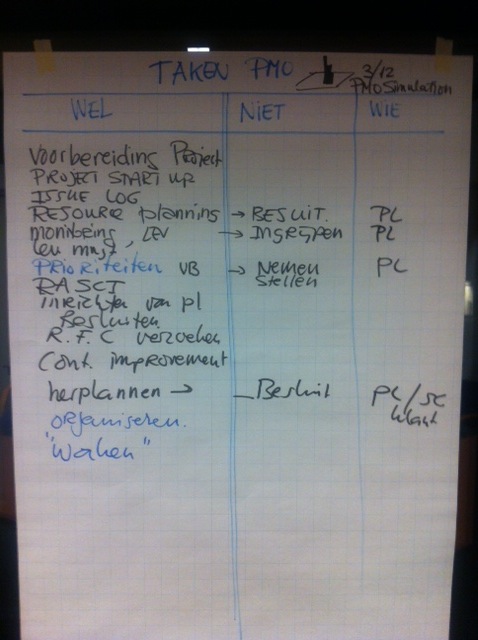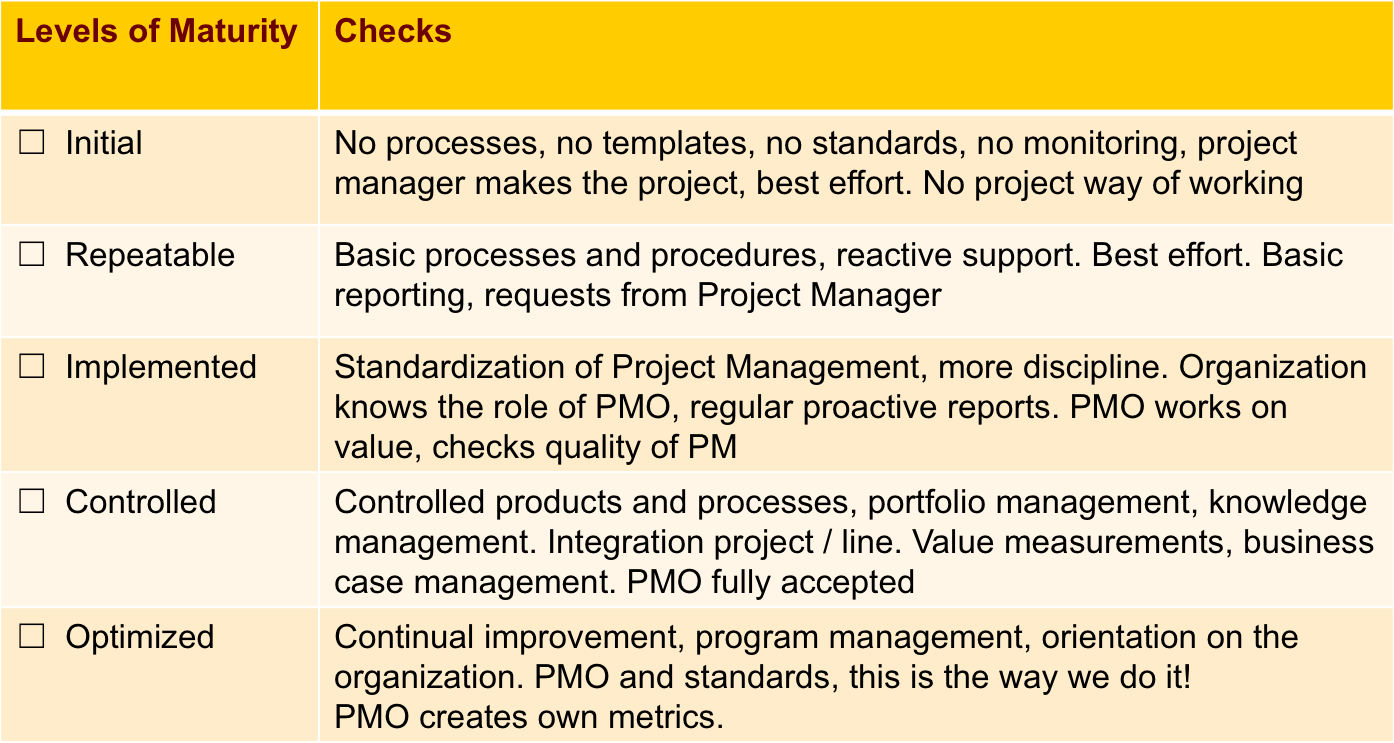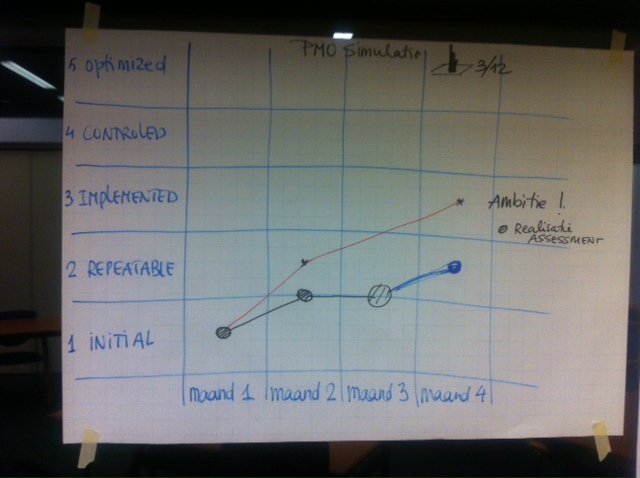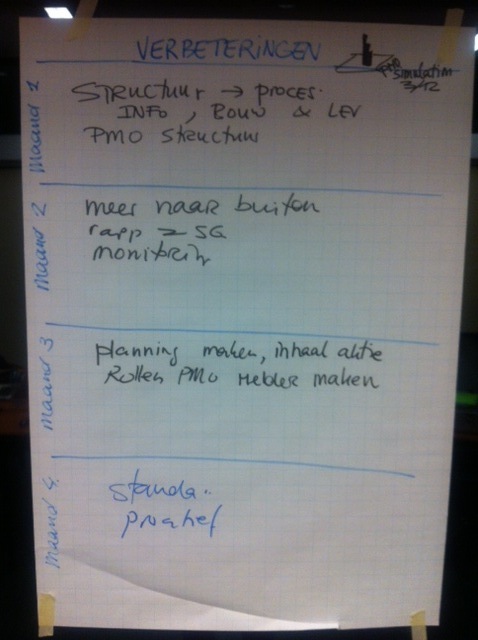Theory without skills doesn’t make your PMO successful
By Jan Schilt GamingWorks
A lot of organizations are reducing their training budget and investments as a result of the financial crises. They are looking for shorter duration training, cheaper interventions such as reading a book or eLearning. They often skip the practical exercises. What is left is often a less effective training. Maybe even a training that is a waste of time and money.
In this blog I want to share with you a case from one of the training programs I recently supported. In this program the customer decided to add a full day simulation to a five-day PMO training program.
I want to demonstrate how the theory and the practical skills were connected to create a much better training outcome. The students experienced how to apply the tools and the theory in a realistic environment, and they found that is was not as easy as they thought it would be to apply the new knowledge. They also came to the conclusion that they thought they knew a lot about PMO and how to organize it, but during the training they became ‘consciously incompetent’. They discovered that they needed more knowledge about certain subjects. Or they need more skills to become successful as a PMO employee.
The PMO training, day 5
Last week I was invited to deliver a PMO Simulation as the last day of a five day PMO training. The target audience was PMO team members who wanted to become better PMO employees. During the first four days they learned:
- PMO roles and responsibilities
- PMO tasks and processes
- Project Management principles and basics
- Tools and instruments
So you can imagine I was quite nervous to have this team of 12 participants in this workshop. I was sure they would easily complete the practical exercises. So I started the session:
“Welcome to this PMO Business Simulation. First exercise for 6 of you is to setup a PMO, organize your team and implement and agree processes. Use all your knowledge and skills from the first 4 days. The other 6 will start the simulated project and prepare the construction of the highest building in the world!”
During the 30 minutes I was observing the team. I saw 6 participants preparing the project and I saw 6 participants sitting and ….doing nothing. I was worried. Why aren’t they starting to setup a PMO? So I asked a few questions.
- “Why aren’t you setting up a PMO?” answer: “How?”
- “Do you know what a PMO is doing?” answer: “Yes?”
- “So, why don’t you start?” answer: “We don’t know?”
Outcomes of round 1
I decided to let them start the simulation even if they were not fully prepared. In my mind I was hoping a little that the project would fail. (sorry, but that’s my facilitator mind, and one of the learning concepts in simulations – learning by mistakes). And I was right. After the first round the outcome of the first reflection was:
- We know the tasks of a PMO but we did not know how to apply them in this project. Who should take the lead in setting up the PMO? We thought the Project Manager would ask us to organize the team, but now we discover we need to start ourselves.
- We did not get any time during project startup to tell the team about our procedures and processes. So, the project started without any reporting and support structure.
- During the project we were not able to deliver the right information because there was no reporting and no tools. As a result the project leader did not receive information and he was not able to steer the project or make decisions.
- During the project it was totally unclear who was doing what. As a result we did the same kind of work on different places. Resource planning was done by the project leader, the PMO and the construction manager. Because of this we did not know how many people we needed and how many we actually had allocated on the project.
Measuring maturity and improving the maturity
I challenged the team to first identify the current maturity of the PMO. We used the following table:
I asked the team: “Where do you position your PMO after round 1?”
The team recognized this table from their theory, but now they experienced how to use it in a realistic case. There was a lot of discussion and by the end they came to the conclusion that they ‘scored’ an “INITIAL”
The team was then tasked to make an improvement plan. So I asked the team: “What is your ambition?” They answered: “Today, we want to become “IMPLEMENTED” “. Based on this ambition they decided first to reach for “REPEATABLE”. In order to reach this level they made the following improvement plan:
- Define and agree processes and procedures. The first ones being:
- How to report ?
- How to handle issues?
- How to plan resources?
- Define the relationship between project manager and PMO
- Design standard reports from PMO to project manager and from PMO to the steering committee
We put all results on flip charts on the wall:
Picture 1 Maturity overview and ambition
Picture 2 Improvement actions after each round.
For many participants, this part of their job was completely new. They understood the table, but they did not practice the usage of the ‘tool’ to improve the performance of the PMO. This was something they did not learn during the training.
What is are the main tasks of a Project Management Office?
During this improvement cycle, a new discussion started. The discussion about ‘Who is doing what?”.
From the theory everybody knew what a PMO should do. Now it became more difficult in this simulation with different people all having their own opinions and ideas. This is something they did not learn during the class.

I decided to help them with an extra flip chart.
On this flip chart we documented:
- Activity of PMO
- Activity not PMO
- But who does it
This resulted in a very useful overview of PMO / non PMO tasks.
Again, they all thought they knew the tasks (understood the theory), but now they had to use this knowledge and apply it in practice. This was not easy!
A little dip between round 2 and 3
By the end of the day the team experienced 3 other improvement cycles and added to the list of tasks. The performance of the PMO increased. The little ‘dip’ between round 2 and 3 was caused by the structure of the simulation. After round 2 we swapped the two teams. The project team became PMO and PMO became project team. This caused another experience they did not learn during the training. “What happens with you if you are put into a PMO department with new processes and procedures?” This is in fact what we simulated. The outcome of the reflection was interesting:
- We need to have time to understand the way of working, we need proper training and support
- If we had standard ways of working, we would not have this ‘dip’
- It’s interesting to experience the other side of the medal. I suddenly experienced the irritating PMO procedure from the perspective of project employee. While in the first two rounds I designed it my self.
- I could now concentrate on the construction of the building since PMO was taking care of the information. I felt the added value of a good performing PMO.
Conclusions by the team
At the end of the day most of the participants came to the same conclusions:
“I thought I new everything about the PMO, but after this day it’s more difficult than I thought to get the PMO up and running!”
“The most difficult part for PMO is to analyze the performance and to improve the performance. Setting the ambition and work towards it!”
“It’s easy to design a report, it’s difficult to get project employees fill it in!”
“Organizing a team is more challenging then I thought, it requires more skills, such as communication, organizing, analyzing, making decisions et cetera!”
Considerations
- Think about combining theory and skills in one training intervention.
- Make sure you explore the day-to-day working issues, and integrate them in the learning intervention.
- Make sure you capture the lessons learned and transfer them to day-to-day work.
If you would like to learn more about this subject contact Jan Schilt



